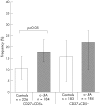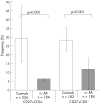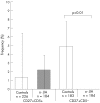Differential expression patterns of recombination-activating genes in individual mature B cells in juvenile idiopathic arthritis
- PMID: 16504994
- PMCID: PMC1798333
- DOI: 10.1136/ard.2005.047878
Differential expression patterns of recombination-activating genes in individual mature B cells in juvenile idiopathic arthritis
Abstract
Background: Re-expression of the recombination-activating genes (RAG) in peripheral B cells may be relevant in the development of autoreactive antibodies in autoimmune diseases. The presence of antinuclear antibodies (ANA) as a hallmark of oligoarticular juvenile idiopathic arthritis (o-JIA, early-onset type) indicates a breakdown in immunological tolerance.
Aim: To examine the expression of RAG genes in peripheral blood mature B lymphocytes in patients with o-JIA.
Methods: 777 memory B cells from peripheral blood, CD19+ CD27+ CD5+ or CD19+ CD27+ CD5-, isolated from three ANA+ children with o-JIA and three healthy age-matched children, were examined for the expression of RAG1 and RAG2 mRNA. mRNA transcripts of activation-induced cytidine deaminase and immunoglobulin G were searched to further determine their developmental stage.
Results: mRNA was present for any of the two RAG genes in the B cells of children with JIA and controls. However, the predominance of RAG1 or RAG2 was different. A significantly decreased frequency of RAG2-expressing memory B cells in both CD5+ and CD5- populations was noted in children with JIA (p<0.001), whereas the number of RAG1-expressing B cells was slightly increased. The coordinate expression of both the RAG genes was a rare event, similar in the CD5+ populations (1% in controls, 2% in children with JIA), but different among the CD5- compartments (5% v 0%; p<0.01).
Conclusion: These results argue for a reduced coordinate RAG expression in the peripheral CD5- memory B cells of patients with o-JIA. Thus, it was hypothesised that impaired receptor revision contributes to autoimmune pathogenesis in JIA.
Conflict of interest statement
Competing interests: None.
Similar articles
-
Analysis of RAG expression by peripheral blood CD5+ and CD5- B cells of patients with childhood systemic lupus erythematosus.Ann Rheum Dis. 2006 Apr;65(4):482-7. doi: 10.1136/ard.2005.040840. Epub 2005 Aug 26. Ann Rheum Dis. 2006. PMID: 16126793 Free PMC article.
-
RAG1 and RAG2 expression by B cell subsets from human tonsil and peripheral blood.J Immunol. 2001 Jan 1;166(1):377-86. doi: 10.4049/jimmunol.166.1.377. J Immunol. 2001. PMID: 11123315
-
Expression of RAGs in peripheral B cells outside germinal centers is associated with the expression of CD5.J Immunol. 2005 May 1;174(9):5553-61. doi: 10.4049/jimmunol.174.9.5553. J Immunol. 2005. PMID: 15843554
-
Expression and reexpression of recombination activating genes: relevance to the development of autoimmune states.Ann N Y Acad Sci. 2005 Jun;1050:10-8. doi: 10.1196/annals.1313.002. Ann N Y Acad Sci. 2005. PMID: 16014516 Review.
-
Signaling pathways regulating RAG expression in B lymphocytes.Autoimmun Rev. 2009 Jun;8(7):599-604. doi: 10.1016/j.autrev.2009.02.004. Epub 2009 Feb 9. Autoimmun Rev. 2009. PMID: 19393209 Review.
Cited by
-
Phosphorothioate-modified CpG oligodeoxynucleotides mimic autoantigens and reveal a potential role for Toll-like receptor 9 in receptor revision.Immunology. 2013 Jun;139(2):166-78. doi: 10.1111/imm.12063. Immunology. 2013. PMID: 23289794 Free PMC article.
-
B Cells on the Stage of Inflammation in Juvenile Idiopathic Arthritis: Leading or Supporting Actors in Disease Pathogenesis?Front Med (Lausanne). 2022 Apr 4;9:851532. doi: 10.3389/fmed.2022.851532. eCollection 2022. Front Med (Lausanne). 2022. PMID: 35449805 Free PMC article. Review.
-
[Concepts on the pathogenesis of juvenile idiopathic arthritis].Z Rheumatol. 2008 Mar;67(2):111-6, 118-20. doi: 10.1007/s00393-008-0276-7. Z Rheumatol. 2008. PMID: 18309499 Review. German.
-
B Cells as a Therapeutic Target in Paediatric Rheumatic Disease.Front Immunol. 2019 Feb 14;10:214. doi: 10.3389/fimmu.2019.00214. eCollection 2019. Front Immunol. 2019. PMID: 30837988 Free PMC article. Review.
-
B-cell pathology in juvenile idiopathic arthritis.Arthritis. 2010;2010:759868. doi: 10.1155/2010/759868. Epub 2010 Dec 2. Arthritis. 2010. PMID: 22076178 Free PMC article.
References
-
- Mombaerts P, Iacomini J, Johnson R S, Herrup K, Tonegawa S, Papaioannou V E. RAG‐1‐deficient mice have no mature B and T lymphocytes. Cell 199268869–877. - PubMed
MeSH terms
Substances
LinkOut - more resources
Full Text Sources
Medical
Research Materials





